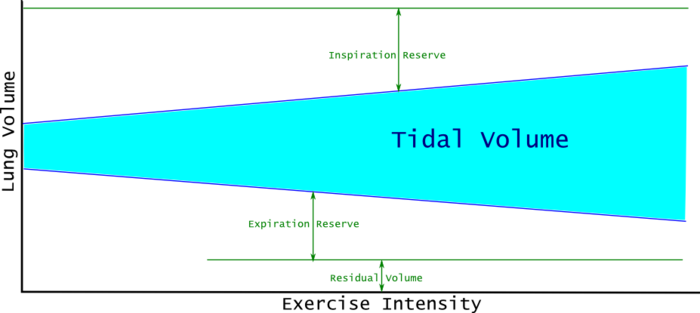Breathing
Revision as of 04:39, 28 March 2013 by User:Fellrnr (User talk:Fellrnr | contribs) (Created page with "A 3D model showing the size and position of the lungs. Breathing is something that we all do naturally, but is often a cause for concern i...")
Revision as of 04:39, 28 March 2013 by User:Fellrnr (User talk:Fellrnr | contribs) (Created page with "A 3D model showing the size and position of the lungs. Breathing is something that we all do naturally, but is often a cause for concern i...")
Breathing is something that we all do naturally, but is often a cause for concern in new runners. Because their fitness is low, they often find themselves out of breath after a short time because their easy running pace is anaerobic. Some general guidelines for breathing:
- As fitness improves, breathing at a given pace becomes easier. This is not because of changes to your lungs, as they don't need to adapt to exercise. The limiting factors for fitness are not related to lung function.
- An easy running pace should be one where you can breathe easily enough to hold a conversation. If you're struggling to breathe, then slow down, but don't run slower than 13 min/mile (7:30 min/km) pace. If you can't maintain that pace, take walking breaks.
- Try to avoid forcing your breathing. Instead, let your breathing come naturally and relax it as much as possible. Breathing hard uses energy, and it's estimated that during maximal exercise breathing takes 10% of the overall energy usage[1].
- Breathe naturally through your mouth and nose. Trying to breathe just through your nose will increase the energy cost of breathing due to the added resistance.
- When exercising, most people breathe more air through a combination of increased frequency and increased volume (depth). Again, try not to force either deep or shallow breathing.
- The burning sensation when you're out of breath is not really a burning, but a physiological perception of the need to breathe more, so you're not damaging your lungs. (The drive is actually to get rid of carbon dioxide rather than to get more oxygen.)
- Breathing deeply in cold weather can irritate your lungs, but this is not the cold itself, but the low humidity that is causing the irritation.
- Most runners will breathe in time with their running stride, using a pattern such as in for two steps, out for two steps. It's possible that matching breathing to strides helps reduce the energy required to breathe. The right breathing pattern should come naturally, and is likely to be different at different paces.
- There are several situations where your breathing could become unusually stressed
- If you are overheating then this can increase your breathing as your body attempts to cool itself through panting.
- If your carbohydrate stores run low, your body will start to burn more fat, and fat requires more oxygen per calorie of energy.
- Because there is less air at altitude, breathing becomes increased. The lack of oxygen confuses the body, as breathing is generally driven by the need to remove CO2 rather than the need to acquire O2. So when the level of CO2 is right, your body does not get enough O2. This tends to cause a feeling of suffocation and trigger conscious breathing to get more O2, which in turn causes the level of CO2 to go too low. When CO2 levels go low, it changes the blood acidity and that messes up the body causing Altitude Sickness, a dangerous and potentially lethal situation. Altitude Training can help prepare for higher altitudes, though it will never compensate completely.
- Obviously asthma can cause breathing problems and it's possible that Intermittent Hypoxic Exposure may help.
In summary, do force or attempt to modify your breathing, but do what comes naturally. Here's a quote from Essentials of Exercise Physiology[2]:
Conscious attempts to modify breathing during running and other general physical activities do not benefit exercise performance. In most instances, conscious manipulation of breathing detracts from the exquisitely regulated ventilator adjustments to exercise.

A simplified graph representing the change in breathing as exercise intensity increases. Note that the increased breath volume comes from both greater inhalation and greater exhalation[3].
References
- ↑ Shephard, R. J. "The oxygen cost of breathing during vigorous exercise." Experimental Physiology 51.4 (1966): 336-350.
- ↑ William D. McArdle, Frank I. Katch, Victor L. Katch, Essentials of exercise physiology, date 2006, publisher Lippincott Williams Wilkins, location Baltimore, MD, isbn 0-7817-4991-3, pages 302
- ↑ William D. McArdle, Frank I. Katch, Victor L. Katch, Essentials of exercise physiology, date 2006, publisher Lippincott Williams Wilkins, location Baltimore, MD, isbn 0-7817-4991-3, pages 301
